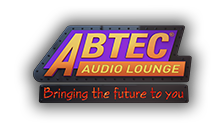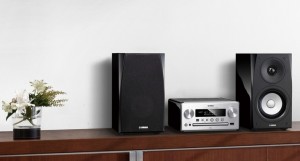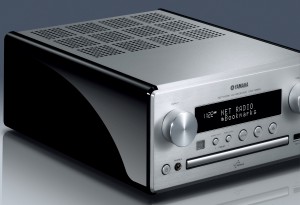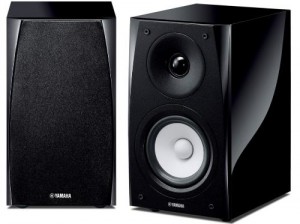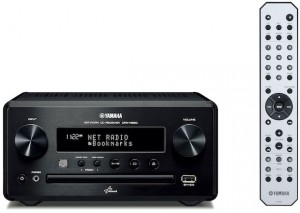The all-in-1, or ‘Mini System’, isn’t a topic we often discuss here on Audio Appraisal. Such words usually hold memories of cheap, plastic budget audio systems, that are as far from hi-fi as it is possible to get.
However, thanks to recent technical advancements, and an increasing lack of space in the modern living environment, all-in-1 systems are gaining in popularity even among audiophiles and music lovers. And, needing a small system for an area where a full-size separates system wasn’t viable option, I decided to investigate the offerings on the market.
I reached out to the awesome folks at Yamaha – and, a day later, the subject of this review – the MCR-N560 all-in-1 networked mini system arrived. A feature-packed, versatile and powerful system, the MCR-N560 comes in 2 flavours. You can purchase the receiver (the CRX-560D) as a separate unit, or as a complete package with the NS-BP182 speakers. For this review, I chose the MCR-N560 – the name Yamaha uses to refer to the complete package.
The CRX-560D
Features
A feature-packed yet still tiny receiver, the CRX-560D can play back media from almost any imaginable source. CD, DAB, FM and USB playback are all covered, as are a hole host of networking features including AirPlay, Spotify Connect, internet radio and DLNA streaming.
2 digital inputs (1 optical and 1 coaxial) allow you to connect external devices such as a TV or blu-ray player. 2 analogue inputs (1 RCA and 1 3.5”) allow you to connect devices such as a phono stage, older portable audio device, etc.
The 36W per channel (6 ohms, 10% THD) efficient digital amplifier feeds the 2 speaker outputs, which feature high quality binding posts rather than the usual spring clips found on most mini systems. And if you need more bass, a mono subwoofer output allows you to connect an active sub to boost your low end response. Yamaha’s digital amplifier technology means that amplification from source to speakers is done without a dedicated DAC chip, further enhancing sound quality. The headphone stage uses a BurrBrown PCM1781 24-bit, 192KHZ DAC. Volume control is also digital domain to guarantee accurate channel separation and stereo imaging.
Networking facilities are limited out-of-the-box to a 10/100 RJ-45 ethernet jack on the back – if you want wifi, you can purchase Yamaha’s YWA-10 wireless network adapter. Optional bluetooth compatibility comes in the form of Yamaha’s YBA-11 bluetooth adapter. I’d like to see Yamaha building wifi technology into their products – especially on a system like this, which is designed primarily to utilise a network. Built-in bluetooth would be nice, too.
Design
As you would expect for a PianoCraft series system, the design of the CRX-N560D is simple and beautiful. Rounded, shaped corners, piano-finish panels and shaped aluminium volume and input selection controls give the yamaha the look and feel of a system costing far more than the £499 SRP.
The sleek, aluminium front panel features the aforementioned volume and input selection controls, and buttons for power, play, pause, stop, next and previous. There’s also a 3.5” headphone jack, a slim CD tray, a USB jack and an IR receiver for the remote.
Just as much thought has gone into the rear panel. High quality binding posts allow you to connect your speakers – and they even support banana plugs thanks to the removable end caps. There are optical and coaxial digital inputs, as well as the all important ethernet jack.
2 Analogue inputs, both RCA and 3.5” are joined by a mono subwoofer output – there’s no stereo analogue output which would’ve been a nice feature. A usb port allows you to power yamaha accessories, such as the YWA-10 or EBA-11 adapters.
My only gripe with the rear panel design is the attached power cable – a plug-in cable would’ve been far easier and nicer to work with. Detachable cables also have the advantage that, should the cable become damaged, you won’t have to open up the unit or send it off for repair.
The NS-BP182
Features
The NS-BP182 speakers benefit from Yamaha’s expertise in speaker and musical instrument design, and incorporate technologies taken directly from Yamaha’s high end Sovo speaker line. A 2-way design, the NS-BP182 speakers feature a 12CM, APMD (Advanced Polymer-injected Mica Diaphragm) woofer and a 3CM soft dome tweeter.
To minimise cabinet vibration, Yamaha developed VCCS (Vibration Control Cabinet Structure), which uses strategically placed pieces of a composite material that provides excellent vibration isolation thereby improving performance.
Sensitivity is a rather low 83DB – meaning they’re harder to drive than, for example, Tannoy’s Mercury V1Is. With that in mind, I was surprised at the rather low power rating of the receiver unit – but numbers can be deceiving.
Design
The front panels feature the same shaped corners as the CRX-560D. There are some screw fixings in sight – though these double up as fixings for the magnetic speaker grills. Fixings for the drivers themselves are, however, hidden behind plastic trims.
The rear panels feature a bass port and the speaker terminals, recessed in a plastic compartment. As with the CRX-560D, only a single set of terminals is provided – there’s no bi-wiring facilities here, though it’s unlikely you’ll need them.
Build Quality
As you would expect from yamaha, build quality of both the system and the speakers it top notch. The casing of the CRX-N560D is well damped – meaning it doesn’t ring when tapped like many cheaper all-in-1 systems. It’s solid, too – with no flexing or rattling when lifted or moved.
The controls have a high end, accurate feel to them – the volume control glideing smoothly with no resistance as the sound level gently raises or lowers. The few buttons are perfectly proportioned and easy to press, with a nice tactile click to them.
The speakers are built to the same high standards. Their solid, wooden cabinets offer up very little resonance when tapped. The solid speaker binding posts, recessed in plastic compartments on the rear panels, are arguably more solid than those found on some hi-fi speakers costing as much as this complete system.
That said, There are a couple of rough edges here and there on the speaker cabinets, particularly towards the back. As with many speakers, the high gloss finish is a magnet for fingermarks and dirt – so keep a soft cloth handy for cleaning.
The grills are cloth-covered plastic, and fairly solid. They’re magnetic, too – snapping neatly into place over the exposed fixings in each corner of the front panel. They’re more than adequate for protecting the cones from prying fingers or accidental bumps and scrapes. If you’re an audiophile, chances are you won’t be using them, and will leave them in the box as I did throughout this review.
Packaging
As with all Yamaha products, the system comes well packed to insure it arrives with you in one piece. Here, however, ‘well packed’ is a huge understatement.
A large main box contains 2 further boxes – 1 for the speakers and 1 for the system itself. A cardboard insert ensures things don’t move where they’re not supposed too – if I were being critical, I’d perhaps have added some handles to aid in lifting the boxes out, as they’re packed tightly.
Inside each box, you’ll find the respective products wrapped in a cloth-like foam material, held in place by blocks of polystyrene. The packaging is similar to that supplied with Yamaha’s separates – it’s simple, effective, and neat, a great first impression.
With the CRX-N560D receiver, you get a remote, some batteries, a radio antenna and some documentation. The NS-BP182 speakers come with some starter cables (with pre-stripped ends – a nice touch), and their grills, lying rather haphazardly underneath the polystyrene protection. Cardboard rectangles cover the tweeters, and self-adhesive wrapping protects the high gloss finish of the front plastics.
The remote
Let’s take a second to talk about that remote. Usually, the remotes supplied with all-in-1 systems are cheap, flimsy, and useless – but not here. The remote supplied with the CXR-N560D is similar to that supplied with many of the components in Yamaha’s hi-fi separates lineup. It’s thick and chunky, with a decent weight to it and excellent build quality all round. The buttons, if a little small, are easy to press and are very tactile – and the range is also excellent, even when it’s not being aimed directly at the receiver.
You’ll need the remote to access the CRX-560D’s menu system, as well as the equaliser – both things that cannot be accessed from the mobile app. I’d like to see the app able to control every aspect of the system, making the remote an optional extra for those who wish to use it.
Operation
The CRX-N560D can be operated either from its front panel (for basic controls), the aforementioned remote, or Yamaha’s NP controller app for iOS or android. I used the NP controller iOS app to operate the unit for this review – and would suggest you do too, as it’s by far the easiest, most convenient way to operate the device. It also has the added advantage of allowing you to stream content directly from your phone or tablet to the device with the best sound quality.
Playing CDS
Playing CDs is as easy as you would expect. UpOn inserting a compatible CD, the unit begins playback automatically. CD text is supported, and CD playback can also be controlled using the mobile app which is a nice touch. The player offers the usual programming modes including shuffle and repeat, and supports direct track access to jump directly to tracks on a disc.
AirPlay
Being an Apple user, By far my favourite feature of the CRX-N560D is the support for Apple’s AirPlay technology – a wireless streaming technology that allows you to stream content from any apple device, or iTunes on your PC or mac, directly to an AirPlay compatible receiver. The CRX-N560D is one such receiver – and throughout my time with the review sample, I spent countless hours streaming both music and podcasts via AirPlay from iTunes on my mac. Not once did I encounter a single dropout, and sound quality was flawless.
One major downside to airplay is volume control. When in AirPlay mode, the volume of the unit can be controlled by the AirPlay device – in this case, the volume of iTunes on my mac. On a couple of occasions, when adjusting the volume using the slider in iTunes, my finger would slip slightly on the trackpad and i’d send the volume rocketing up to maximum. It’s an issue inherent in many AirPlay devices – but it would be nice to be able to set a volume limit.
Dab/FM
Playback of DAB/FM stations is, as you would expect, easy. The tuner too can be controlled via the mobile app, and the app is able to display the RDS station information and frequency. It also displays the bitrate of DAB stations, which is a nice touch.
There are 30 presets to store your favourite stations. Sound quality of DAB/FM broadcasts is great across the board – with very little background noise on the FM side and none on the DAB side as you would expect. AM is notable only by its absence- a shame, though not surprising.
USB
Via its front USB port, the CRX-N560D enables you to play content from USB flash drives or apple iDevices such as the iPod, iPhone or iPad. The unit supports all common file formats, including WAV, MP3, WMA, FLAC and AAC. The unit supports sampling rates of up to 192KHZ WAV and FLAC files, and 48KHZ for all other file types.
By far the easiest way to control playback of content from a USB device is via the NP Controller app. connecting a USB device and tapping the USB source icon reveals a list of folders, from which you can select your files. During playback, the artist, title, and album are displayed, as well as the elapsed time.
When connecting an apple device, playback is controlled on the device itself – and the unit will charge the device while it’s plugged in.
It’s worth noting that the CRX-N560 doesn’t appear to support gapless playback from USB devices – however, it does from all other sources including CD, AirPlay and the app. It’s worth noting also that this could be due to the speed of the drive, which will affect the time the unit takes to load the track into its buffer memory.
Streaming From The Network
The CRX-N560D can stream from DLNA-compliant network devices, as well as PCs configured to act as media servers. The unit had no problem streaming MP3, FLAC and WAV files from an external hard drive connected to my Asus RT-AC66U router, using the router’s built-in DLNA media server.
Music can be browsed by artist, album, genre or playlist – and there’s the ability to browse the folder structure too, in case the unit missed some files while searching your device. Interestingly, the app gives you the option to display pictures – a function that I find somewhat unnecessary on a hi-fi system. Not having any pictures on the NAS drive, I have no idea what this function is intended for – and whether or not it works.
Internet Radio
With the onboard vTuner internet radio service, the CRX-N560D gives you access to thousands of internet radio stations, covering almost every imaginable genre. Stations can be browsed by location, genre, New or Popular, and there’s a section for podcasts too. You can bookmark your favourite stations to return to them later, and there’s a handy help function if you should get stuck.
Quality varies from station to station, with some being lower resolution streams than others – most, however, are perfectly acceptable and the Yamaha’s digital processing hardware means they sound, for the most part, better than DAB. Station information, such as the current track, is displayed if supported by the station you’re listening too.
Streaming From The App
As with most streamers, the CRX-N560D allows you to stream content directly from your portable device via the NP Controller app. Streaming is faultless – with no dropouts. As all data is sent over the network in digital form, there is no degradation in sound quality, and the digital music benefits from the processing technology inside the yamaha to achieve the best sound possible.
Content can be browsed album, artist, songs, genres or composers, all presented (on iOS at least) in an interface reminiscent of the native Music app.
Spotify
As with most network-capable components, the Yamaha supports Spotify connect – not being a Spotify user, I didn’t use this function. However – playback can be controlled by the mobile app as with every other function, and given that the digital tracks will be processed by the CRX-N560d’s digital hardware, it should sound no different to the other digital sources.
The sound
All-in-1 systems aren’t renowned for their sound quality – in fact, the tiny, mesh-fronted speakers, cheap chip-based amps, and thin speaker cables for which all-in-1 systems are known are enough to send most audiophiles running in the opposite direction. In the case of the MCR-N560, though, that couldn’t be further from the truth.
Straight out of the box, the system presents a warm, luscious sound that only gets sweeter as the system is allowed time to break in. Yamaha recommend at least 72 hours for the system, in particular the speakers, to loosen up and achieve optimal sound quality. I definitely found that to be accurate – after this time, the sound stage had opened up considerably, the bass was tighter, and the system displayed a sweeter, more laid back presentation.
Unusually given its networking capabilities, the first thing I did was to hook up my phono stage, and a Pro-ject Debut carbon to the aux inputs – and, within minutes, Roger Taylor’s Fun On Earth album was flowing from the speakers. By far one of my favourite test albums of the moment – the song ‘Say It’s Not True’, in particular, contains an amazing Guitar solo, extensive use of reverb, and a fantastic bass line. And it wouldn’t be a Roger Taylor album without hard-hitting, powerful drums that will bring all but the most controlled of systems to their knees.
The MCR-N560, however, put in a staggering, unruffled performance. The music flowed every which way from the speakers, spreading around my listening room paining a beautiful musical picture. The bass was delivered with precision, the deepest notes defying the size of the speaker drivers with their rich warmth and tone. Highs are silky smooth, but never bright – and the sound stage is deep and totally 3-dimensional, allowing you to hear right into the heart of the music.
So, a great first impression, then – and as I delved deeper into my vinyl collection, my smile became wider. Next was Queen’s ‘A Day At The Races’ – ‘you take my breath away’, a song featuring only piano and Queen’s legendary harmonised vocals was beautiful to behold. Tape hiss and all – the yamaha delivered the track with all the sparkle and grace with which Freddie had intended.
Load up a USB flash drive containing some Eric Clapton, and the Yamaha continues to impress. ‘Next Time You See Her’ is rhythmic, those sharp hi-hat strikes brought to the forefront of the mix. Instrument placement is faultless, and the individual instruments, particularly the left-panned acoustic guitar, are easy to discern. It’s the Yamaha’s attention to detail that impresses me the most here – it even managed to portray the slight distortion present in the recording during the final floor tom hit.
While it’s no power house, the MCR-N560 can certainly deliver the goods when the party gets started. Sure, if played wide open there is some distortion – but that is to be expected, and no amplifier should ever be pushed that hard. That said, even driving the 83DB sensitivity NS-BP180 speakers, the CRX-N560 powered through Meat Loaf’s ‘Life Is A Lemon And I Want My Money Back’ with gusto. The chest-pounding rhythm, awesome harmonies, and the Yamaha’s impeccable agility and sense of timing added up to an immensely enjoyable performance that had me hooked from beginning to end.
It was with high expectations that I reached for a pair of headphones. And, if the CRX-N560 didn’t meet those expectations, it exceeded them by a million miles. Sure, there is some noticeable background hiss – but crank up the tunes and it soon becomes inaudible. Plus, you’ll be so lost in the music, you won’t care.
Summary
I honestly can’t recommend this system enough. For a suggested retail price of £499, you’re getting a streamer, CD player, an awesome DAC, and a sweet stereo amp – all crammed into 1 tiny box that’s barely bigger than a DVD box set. You also get one of the best pairs of budget bookshelf speakers on the market. If you’re feeling up to some system matching, you can purchase the CRX-N560D receiver as a separate unit – but why would you want too? The synergy between these components has to be heard to be believed.
The MCR-N560 does what any good system should – lets you focus on the music. I’m summarising this review, with Norah Jones playing in the background. But not on my reference system… no, on the little Yamaha MCR-N560. If that’s not praise enough, I don’t know what is.
I’m not saying it’s as good as my reference system – a 36W per channel digital amplifier is no match for a 200W per channel class XD amplifier that, despite its huge heatsinks, becomes hotter than the sun after a half hour’s use. But the MCR-N560 brings something to the table that only the best hi-fi systems can match – and that’s sheer musical enjoyment. Add the fact that it’s easy to setup, great to look at, a pleasure to use, and so versatile in its features… and ask yourself. what more could you want?
Read more at: http://www.audioappraisal.com/yamaha-mcr-n560-review/
Where to buy Yamaha: http://abtec.co.nz/product-search.php?keyword=Keywords&category=&brand=88&search=
